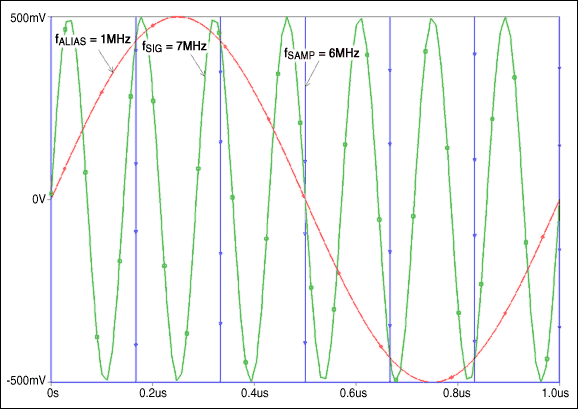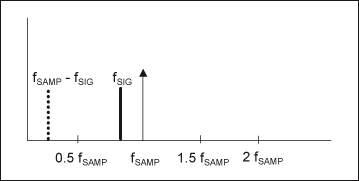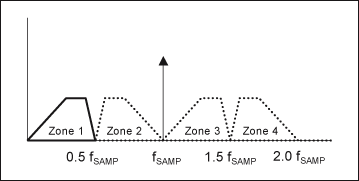Abstract: This application note provides a fast and easy-to-use tool for determining the true location of image signals and the location of overlapping frequencies, as well as harmonic frequencies in a typical spectrum. The data obtained is used to analyze the dynamic characteristics of analog-to-digital converter (ADC) and digital-to-analog converter (DAC). This calculation tool is based on an Excel spreadsheet and can be downloaded via the link provided in the application note.
This Excel®-based, easy-to-use overlapping frequency calculator provides a fast way to locate fundamental harmonics in the first Nyquist band of a data sampling system. This calculator has nothing to do with the sampling process, the system can work in Nyquist sampling, oversampling or undersampling. This tool is very useful for determining the overlapping spectrum of ADC and DAC in the first Nyquist band.
This application note discusses methods for calculating the aliasing frequency in the first Nyquist band, including detailed instructions for using the overlapping frequency calculator. In addition, in order to improve understanding, the article briefly discusses the concept of aliasing frequency and Nyquist frequency in a data sampling system or a specific data converter. The aliasing frequency and the Nyquist frequency are well known, and there is frequency aliasing in the data sampling system. When a signal is sampled with a clock lower than the Nyquist frequency, frequency aliasing will occur. It is twice the bandwidth of the signal band. The signal spectrum in the real world contains fundamental harmonics, as well as noise inside and outside the frequency band. The inherent nonlinearity of the system and the nonlinearity of the sampling process will generate harmonic components of the fundamental wave in the output waveform. All higher harmonics higher than fSAMP / 2, fSAMP is the sampling frequency, and the aliasing frequency will enter the first Nyquist band (Figure 1a, 1b).

Figure 1a. Aliasing in the time domain

Figure 1b. Aliasing in the frequency domain
The fast Fourier transform (FFT) spectrum of the discrete time-domain signal can be divided into an infinite number of fSAMP / 2 frequency bands, namely the Nyquist band. The spectrum between DC and fSAMP / 2 is the first Nyquist band. The spectral components are repeated in different Nyquist bands. Note: The even-order Nyquist band is a mirror image of the odd-order Nyquist band (Figure 2).

Figure 2. Schematic diagram of multiple Nyquist bands. Frequency aliasing of ADCs and DACs Aliasing in ADCs is generated by the sample / hold (T / H) process of the analog signal at the input stage. In the field of digital signal processing (DSP), the T / H process is equal to the convolution of the spectrum of the pulse sequence (determined by the sampling clock) and the analog input spectrum. The convolution results produce periodic spectra in different Nyquist bands. When the input signal contains spectral components greater than the Nyquist frequency (fSAMP / 2), adjacent Nyquist bands will overlap each other, resulting in frequency aliasing.
The aliasing in the DAC is caused by the zero-order hold (ZOH) process of discrete-time sampling at the output stage (zero-order hold is used to avoid code-related pulse interference). The zero-order hold process in the DSP field is equal to the convolution of the sin (x) / x spectrum (represented as a rectangular function used to hold discrete-time samples) and the DAC core output pulse sequence spectrum (amplitude change). In addition, like the ADC, the periodic output spectrum of different Nyquist bands is the result of convolution. From a mathematical point of view, if there is no frequency aliasing, all frequency components below fSAMP / 2 will appear in the frequency spectrum. However, due to frequency aliasing, any harmonic component (fHARM) higher than fSAMP / 2 will also appear as an image frequency with the frequency: | ± K x fSAMP ± fHARM |, where K = 1, 2, 3, etc.
The following operation is used to calculate the different harmonics in the first Nyquist band: fNYQ = fSAMP / 2; fHARM = N x fFUND; // N is an integer If (fHARM lies in an odd Nyquist zone) then fLOC = fHARM % fFUND; //% is the modulus operator else fLOC = fFUND-(fHARM% fFUND); End; where fNYQ is the Nyquist frequency, fSAMP is the sampling frequency, fFUND is the signal fundamental frequency, and fHARM is the signal harmonic frequency , FLOC is the position of the harmonic component in the first Nyquist band.
Using a simple electronic calculator to find the location (fLOC) of different harmonic frequencies (fHARM), the number of iterations must first be determined. To simplify this process, you can download the "Overlap Frequency Calculator" Excel spreadsheet.
Two input variables are required for the calculation of the overlapping frequency calculator: sampling frequency fSAMP and signal fundamental frequency fFUND. Through these two variables, the calculator can find the Nyquist frequency (fNYQ), the absolute value of different harmonic frequencies (fHARM), and the different harmonics of the first Nyquist band in the overlapping spectrum. Table 1 gives an example of calculating the overlapping frequency.
Table 1. Overlap frequency calculation (enter fSAMP = 500.000000, fFUND = 29.96826172)
Reference download application: Coherent Sampling Calculator (CSC)
This Excel®-based, easy-to-use overlapping frequency calculator provides a fast way to locate fundamental harmonics in the first Nyquist band of a data sampling system. This calculator has nothing to do with the sampling process, the system can work in Nyquist sampling, oversampling or undersampling. This tool is very useful for determining the overlapping spectrum of ADC and DAC in the first Nyquist band.
This application note discusses methods for calculating the aliasing frequency in the first Nyquist band, including detailed instructions for using the overlapping frequency calculator. In addition, in order to improve understanding, the article briefly discusses the concept of aliasing frequency and Nyquist frequency in a data sampling system or a specific data converter. The aliasing frequency and the Nyquist frequency are well known, and there is frequency aliasing in the data sampling system. When a signal is sampled with a clock lower than the Nyquist frequency, frequency aliasing will occur. It is twice the bandwidth of the signal band. The signal spectrum in the real world contains fundamental harmonics, as well as noise inside and outside the frequency band. The inherent nonlinearity of the system and the nonlinearity of the sampling process will generate harmonic components of the fundamental wave in the output waveform. All higher harmonics higher than fSAMP / 2, fSAMP is the sampling frequency, and the aliasing frequency will enter the first Nyquist band (Figure 1a, 1b).

Figure 1a. Aliasing in the time domain

Figure 1b. Aliasing in the frequency domain
The fast Fourier transform (FFT) spectrum of the discrete time-domain signal can be divided into an infinite number of fSAMP / 2 frequency bands, namely the Nyquist band. The spectrum between DC and fSAMP / 2 is the first Nyquist band. The spectral components are repeated in different Nyquist bands. Note: The even-order Nyquist band is a mirror image of the odd-order Nyquist band (Figure 2).

Figure 2. Schematic diagram of multiple Nyquist bands. Frequency aliasing of ADCs and DACs Aliasing in ADCs is generated by the sample / hold (T / H) process of the analog signal at the input stage. In the field of digital signal processing (DSP), the T / H process is equal to the convolution of the spectrum of the pulse sequence (determined by the sampling clock) and the analog input spectrum. The convolution results produce periodic spectra in different Nyquist bands. When the input signal contains spectral components greater than the Nyquist frequency (fSAMP / 2), adjacent Nyquist bands will overlap each other, resulting in frequency aliasing.
The aliasing in the DAC is caused by the zero-order hold (ZOH) process of discrete-time sampling at the output stage (zero-order hold is used to avoid code-related pulse interference). The zero-order hold process in the DSP field is equal to the convolution of the sin (x) / x spectrum (represented as a rectangular function used to hold discrete-time samples) and the DAC core output pulse sequence spectrum (amplitude change). In addition, like the ADC, the periodic output spectrum of different Nyquist bands is the result of convolution. From a mathematical point of view, if there is no frequency aliasing, all frequency components below fSAMP / 2 will appear in the frequency spectrum. However, due to frequency aliasing, any harmonic component (fHARM) higher than fSAMP / 2 will also appear as an image frequency with the frequency: | ± K x fSAMP ± fHARM |, where K = 1, 2, 3, etc.
The following operation is used to calculate the different harmonics in the first Nyquist band: fNYQ = fSAMP / 2; fHARM = N x fFUND; // N is an integer If (fHARM lies in an odd Nyquist zone) then fLOC = fHARM % fFUND; //% is the modulus operator else fLOC = fFUND-(fHARM% fFUND); End; where fNYQ is the Nyquist frequency, fSAMP is the sampling frequency, fFUND is the signal fundamental frequency, and fHARM is the signal harmonic frequency , FLOC is the position of the harmonic component in the first Nyquist band.
Using a simple electronic calculator to find the location (fLOC) of different harmonic frequencies (fHARM), the number of iterations must first be determined. To simplify this process, you can download the "Overlap Frequency Calculator" Excel spreadsheet.
Two input variables are required for the calculation of the overlapping frequency calculator: sampling frequency fSAMP and signal fundamental frequency fFUND. Through these two variables, the calculator can find the Nyquist frequency (fNYQ), the absolute value of different harmonic frequencies (fHARM), and the different harmonics of the first Nyquist band in the overlapping spectrum. Table 1 gives an example of calculating the overlapping frequency.
Table 1. Overlap frequency calculation (enter fSAMP = 500.000000, fFUND = 29.96826172)
| N | fNYQ (MHZ) | fHARM (MHz) | fLOC (MHz) |
| 1 | 250.000000 | 29.96826172 | 29.96826172 |
| 2 | 59.93652344 | 59.93652344 | |
| 3 | 89.90478515 | 89.90478515 | |
| 4 | 119.8730469 | 119.8730469 | |
| 5 | 149.8413086 | 149.8413086 | |
| 6 | 179.8095703 | 179.8095703 | |
| 7 | 209.777832 | 209.777832 | |
| 8 | 239.7460937 | 239.7460937 | |
| 9 | 269.7143555 | 230.2856445 | |
| 10 | 299.6826172 | 200.3173828 | |
| 11 | 329.6508789 | 170.3491211 | |
| 12 | 359.6191406 | 140.3808594 | |
| 13 | 389.5874023 | 110.4125977 | |
| 14 | 419.5556641 | 80.44433595 | |
| 15 | 449.5239258 | 50.47607423 |
Reference download application: Coherent Sampling Calculator (CSC)
Big Suction Robotic Vacuum Cleaner
Big Suction Robotic Vacuum Cleaner,Robotic Vacuum Cleaner,Carpet Cyclone Vacuum Cleaner,Water Filtration Vacuum Cleaner Robot
NingBo CaiNiao Intelligent Technology Co., LTD , https://www.intelligentnewbot.com